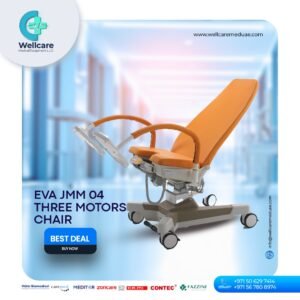Defibrillator Equipment supplier in UAE
The importance of having a reliable defibrillator equipment supplier in the UAE, such as Wellcare Medical Equipment LLC, cannot be overstated. In a region where cardiac emergencies are a leading cause of sudden death, the availability and accessibility of high-quality defibrillators are critical for improving survival rates. Wellcare Medical Equipment LLC plays a crucial role in bridging the gap between advanced medical technology and healthcare facilities across the UAE. By supplying a comprehensive range of defibrillator equipment, they ensure that hospitals, clinics, emergency responders, and even public spaces are equipped to handle cardiac arrest incidents effectively. This is particularly significant in the UAE, where rapid urbanization and a growing population demand robust healthcare infrastructure. Wellcare’s commitment to providing state-of-the-art defibrillators, along with comprehensive training and maintenance services, ensures that both medical professionals and laypersons are prepared to respond to emergencies. This not only enhances the overall emergency medical response system but also fosters a culture of preparedness and resilience within the community. In essence, Wellcare Medical Equipment LLC’s role as a defibrillator supplier is vital for safeguarding public health and improving outcomes in life-threatening cardiac emergencies throughout the UAE.
The presence of a reliable defibrillator equipment supplier in the UAE, such as Wellcare Medical Equipment LLC, has several key impacts on the healthcare system and overall public health. Here’s an in-depth explanation:
Enhancing Emergency Medical Response
A trustworthy supplier like Wellcare ensures that defibrillators are readily available in critical locations, such as hospitals, clinics, public spaces, and ambulances. This widespread availability significantly improves the emergency medical response to sudden cardiac arrest (SCA), where immediate defibrillation is crucial. The timely intervention made possible by easily accessible defibrillators can drastically increase survival rates, as every minute without defibrillation reduces the chance of survival by about 10%.
Supporting Healthcare Infrastructure
Wellcare Medical Equipment LLC provides high-quality defibrillators that adhere to international standards, ensuring reliability and effectiveness. This support bolsters the healthcare infrastructure in the UAE by equipping it with advanced medical devices that healthcare professionals can depend on. High-quality equipment reduces the risk of malfunction during critical moments, ensuring that patients receive the best possible care during emergencies.
Training and Education
An important aspect of Wellcare’s service is the training and education they provide to healthcare professionals and the general public. Proper training on the use of Automated External Defibrillators (AEDs) and other defibrillator equipment ensures that responders are confident and capable of performing life-saving procedures. This training not only enhances the skills of medical personnel but also empowers ordinary citizens to act effectively in emergencies, thereby increasing community resilience.
Public Health and Safety
By making defibrillators available in public places and ensuring that a wide range of people are trained to use them, Wellcare contributes to overall public health and safety. AEDs in locations like airports, schools, shopping malls, and sports facilities mean that lifesaving equipment is within reach when sudden cardiac arrest occurs. This proactive approach to public health reduces the burden on emergency medical services and improves outcomes for individuals experiencing cardiac emergencies outside of a hospital setting.
Innovation and Technological Advancement
Wellcare Medical Equipment LLC’s commitment to supplying the latest defibrillator technologies ensures that the UAE’s healthcare system remains at the forefront of medical advancements. Modern defibrillators equipped with features like real-time CPR feedback, data recording, and wireless connectivity enhance the effectiveness of emergency response and patient care. By incorporating these advanced technologies, Wellcare helps drive innovation within the healthcare sector.
Community Resilience
The strategic distribution and availability of defibrillators, coupled with comprehensive training programs, foster a sense of preparedness and resilience within communities. People are more likely to intervene and provide assistance during cardiac emergencies when they know that defibrillators are accessible and they are trained to use them. This community-based approach not only saves lives but also builds a supportive and responsive society.
Improved Health Outcomes
Ultimately, the presence of a reliable defibrillator supplier like Well care Medical Equipment LLC leads to improved health outcomes. Rapid defibrillation during cardiac arrest can prevent severe neurological damage and other complications associated with delayed treatment. By ensuring that defibrillators are available and functional when needed, Wellcare contributes to better long-term health outcomes for patients who experience sudden cardiac arrest.
In summary, the key impacts of a defibrillator equipment supplier like Well care Medical Equipment LLC in the UAE include enhanced emergency medical response, strengthened healthcare infrastructure, comprehensive training and education, improved public health and safety, technological innovation, increased community resilience, and better health outcomes. These impacts collectively contribute to a more robust and effective healthcare system capable of saving lives and improving the quality of care in the UAE.




